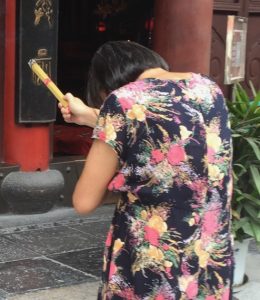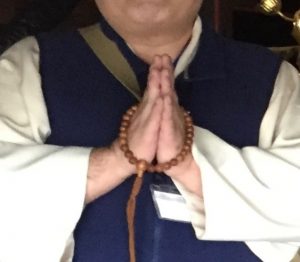
By Rev. Ken Yamada
The smell of incense pervades our temples. What does it mean?
Burning incense is a universal ritual throughout Buddhism. Knowing its meaning helps us appreciate its purpose.
Different types of Buddhism have different rituals and ceremonies using incense. Jodo Shinshu for instance, uses incense differently than say, Chinese Buddhism.
Incense’s origin is unclear but it’s been in India since ancient times. According to one story, the Buddha was giving a sermon when suddenly a disciple swatted a mosquito. The Buddha asked thereafter incense be lit during his talks to repel insects and avoid the needless taking of life.
Today, incense is common in temple altars and home altars. When visiting temples or attending service, people offer incense by placing it in the temple’s incense burner, typically a large metal urn. In Jodo Shinshu temples, incense burners sit inside the temple, usually in front of the altar. By contrast in China, large incense burners typically stand outside the temple’s front entrance.
In Tokyo, a large iron incense burner sits outside Sensōji temple, a popular tourist site, where hordes of people offer incense and wave its smoke towards their bodies and heads, believing the burning incense will cure illnesses, keep them healthy, give them good luck, or make them smarter. I’ve seen incense offered to a temple’s main statue, such as to Amida Buddha or Kannon (bodhisattva of compassion) for various reasons, for example, in hopes of curing a sick family member, succeeding in business, winning the lottery, or passing a school exam. I’ve even seen young women in China offer incense in hope of marrying a successful mate.

The Buddhist incense ritual is called O-shōkō in Japanese (焼香), which literally means “burn incense.” It’s presented as an offering,” thus it’s called “incense offering.”
All major world religions use incense in rituals, including Christianity, Islam, Hinduism and Islam. I read it’s even used in paganism and devil worship. Whatever the case, I think incense helps create a sacred, holy, and contemplative atmosphere.
Studies show incense helps people feel relaxed, reduce stress, raise their mental awareness, relieve depression, boost their immune system and spur creativity. Incense is used in Indian Ayurvedic and holistic medicine.
In Japan, the “art of incense” is called Kōdō (香道), “Way of Fragrance,” a tradition much like tea ceremony, flower arrangement and calligraphy. This tradition originated in 16th Century Japan, involving specialized pottery, utensils, containers, trays, incense holders, vases, tongs, brushes, and cabinets. Incense was made from rare and unusual woods, such as sandalwood, agar, cinnamon bark, clove, and lavender, and could be quite expensive. Aristocrats hosted mōnko, “listening to incense” gatherings, guessing the kind of incense by sniffing it, similar to how wine connoisseurs guess a wine’s vintage. Kōdō still is practiced today.
In Jodo Shinshu, people may offer incense whenever visiting a temple. They also offer incense at services—either before, during, or after, depending on the temple and service. Protocol varies widely.
To offer incense, according to our Higashi Honganji tradition, simply put two pinches of ground incense in the burner, place both hands together in “gassho” position, recite “Namu Amida Butsu,” put your hands down, bow once and step away.

Usually we take stick incense and break it into half or thirds, light it, and place it lying down in a burner. Ground incense typically is used for services, pinches of which are put into an incense burner containing a thumb-size piece of charcoal. By contrast in some other traditions, long sticks of burning incense are placed standing in burners.
Personally, I don’t like smoky incense. It makes me cough. Some people are allergic to smoke. I prefer to use “low smoke” incense. Some temples even installed special ventilation systems, which catch smoke rising from incense burners. I’ve seen offerings done with unlit incense, for example, in a hospital room.
Throughout Buddhism’s history, incense use has been interpreted in different ways, sometimes mixed with folk beliefs. Incense is commonly seen as a purifier, its sweet fragrance cleansing the air. Some people think it purifies their thoughts and actions. Others believe it’ll help them accumulate “good” karma or merit that extinguishes their sins and enable them to go to the Pure Land when they die. However, these beliefs don’t follow the teachings of Jodo Shinshu’s founder, Shinran Shonin.
For Shinran, understanding one’s true nature is key to understanding life. We are ignorant beings, who constantly cling to self-centered views and desires. We suffer because we don’t truly understand and accept the great truths of impermanence and interdependence. We see the world through the eyes of dualism, constantly splitting life into good and bad, life and death, and “I” versus others.
In this light, incense teaches us Dharma, great truth about ourselves. For example, when lit, incense is both living and dying simultaneously, just like us. This shows life and death as inseparable and One. Burning incense—fire—only burns because of the wood. This shows the truth of interdependence. One cannot exist without the other, just how we cannot live without others. The smoke drifts away and disappears. This is the truth of impermanence, dynamic change, which means nothing lasts forever.
How do you judge good incense? Is it the wood, shape, flame, or smoke? Actually, it’s the smell. In Kōdō, incense is placed on a small mica (mineral) plate, which sits atop a hot charcoal. This way, the incense itself doesn’t burn, but heats up, releasing the wood’s fragrance.
For me, this fragrance is most important in Buddhism. When all else has disappeared—wood, flame, and smoke—the fragrance remains. This teaches us dharma. When offering incense at memorial services, we are reminded that a loved one’s physical form has disappeared, but through our memories, thoughts and feelings, our connection to that person remains. Together we are One.
Moreover, the smell of incense symbolizes Buddha dharma, truth that awakens us. We receive truth—wisdom’s light—when we visit the temple. Like the smoke of incense, the Dharma subtly sinks into our body and minds. Its scent follows us, wherever we go.
In a poem, Shinran wrote:
People imbued with incense,
Bear the fragrance on their bodies;
They are called
Those adorned with the fragrance of light.
(Jōdo Wasan 116)
-Rev. Yamada, editor at Shinshu Center of America, is based in Berkeley, California

